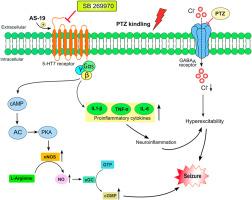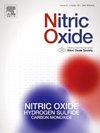5-HT7受体拮抗剂SB269970通过调节NO/cGMP信号通路和神经炎症减轻戊四氮唑诱导大鼠癫痫模型的发作
IF 3.2
2区 生物学
Q2 BIOCHEMISTRY & MOLECULAR BIOLOGY
引用次数: 0
摘要
癫痫是一种影响生活质量的疾病,其特征是由于大脑兴奋和抑制系统之间的平衡被破坏而导致神经元过度放电,其病理生理学尚未完全阐明。在本研究中,我们研究了血清素7 (5-HT7)受体拮抗剂SB 269970对戊四氮唑(PTZ)诱导癫痫模型癫痫发作的影响。选用体重230 ~ 250 g的雄性Wistar Albino大鼠70只,随机分为对照组和给药组。大鼠分别给予预定剂量的sb269970 (3mg /kg)、5- ht7激动剂as19 (5mg /kg)、7-NI (nNOS抑制剂,50mg /kg)、YC-1(鸟苷酸环化酶激活剂,10 μg/kg)。腹腔注射PTZ (35 mg/kg)诱导癫痫发作。采用拉辛量表评估癫痫发作阶段。经皮质电图(ECoG)和视频记录后处死大鼠,采用生化方法测定海马组织中一氧化氮(NO)、cGMP、nNOS和促炎细胞因子(TNF-α、IL-1β和IL-6)水平。结果表明,注射SB 269970后,大鼠癫痫发作阈值升高,癫痫发作次数减少。此外,SB 269970可显著降低大鼠海马组织中因癫痫发作而升高的促炎因子(TNF-α、IL-6、IL-1β)及NO、cGMP、nNOS水平。相反,给药5-HT7激动剂AS-19增加了癫痫发作次数,引起海马促炎细胞因子和NO、cGMP、nNOS水平升高。综上所述,SB 269970通过抑制NO/cGMP通路和海马组织中促炎细胞因子(TNF-α、IL-1β和IL-6)水平而具有抗惊厥活性。然而,5-HT7拮抗剂药物作为治疗癫痫的一种选择还需要进一步的分子研究。本文章由计算机程序翻译,如有差异,请以英文原文为准。

5-HT7 receptor antagonist SB269970 attenuates seizures by modulating NO/cGMP signaling pathway and neuroinflammation in a pentylenetetrazol-induced epilepsy model in rats
Epilepsy is a disease affecting the quality of life, characterized by neuronal excessive discharges resulting from the disruption of the balance between excitatory and inhibitory systems in the brain, and its pathophysiology has not been fully elucidated. In this study, we investigated the effects of serotonin 7 (5-HT7) receptor antagonist SB 269970 on seizures in a pentylenetetrazol (PTZ)-induced epilepsy model. Seventy male Wistar Albino rats (weight 230–250 g) were used in the study and the rats were randomly assigned to control and drug groups. Predetermined doses of SB 269970 (3 mg/kg), 5-HT7 agonist AS 19 (5 mg/kg), 7-NI (nNOS inhibitor, 50 mg/kg), YC-1 (guanylate cyclase activator, 10 μg/kg) were administered to the rats. PTZ (35 mg/kg) was injected intraperitoneally to induce seizures. The Racine scale was used to evaluate seizure stages. After electrocorticography (ECoG) and video recordings, the rats were sacrificed and nitric oxide (NO), cGMP, nNOS and proinflammatory cytokines (TNF-α, IL-1β and IL-6) levels in hippocampal tissue were measured by biochemical methods. The study results showed that the seizure threshold increased and the number of seizures decreased in rats administered SB 269970. In addition, the levels of proinflammatory cytokines (TNF-α, IL-6, IL-1β) and NO, cGMP and nNOS, which are increased with seizures in the hippocampal tissue, were significantly decreased by the administration of SB 269970. In contrast, the administration of 5-HT7 agonist AS-19 increased the number of seizures and caused an increase in the levels of hippocampal proinflammatory cytokines and NO, cGMP and nNOS. In conclusion, the findings of this study revealed that SB 269970 causes anticonvulsant activity by inhibiting the NO/cGMP pathway and proinflammatory cytokine (TNF-α, IL-1β and IL-6) levels in the hippocampal tissue. However, further molecular studies are needed for 5-HT7 antagonist drugs to be an option in the treatment of epilepsy.
求助全文
通过发布文献求助,成功后即可免费获取论文全文。
去求助
来源期刊

Nitric oxide : biology and chemistry
生物-生化与分子生物学
CiteScore
7.50
自引率
7.70%
发文量
74
审稿时长
52 days
期刊介绍:
Nitric Oxide includes original research, methodology papers and reviews relating to nitric oxide and other gasotransmitters such as hydrogen sulfide and carbon monoxide. Special emphasis is placed on the biological chemistry, physiology, pharmacology, enzymology and pathological significance of these molecules in human health and disease. The journal also accepts manuscripts relating to plant and microbial studies involving these molecules.
 求助内容:
求助内容: 应助结果提醒方式:
应助结果提醒方式:


